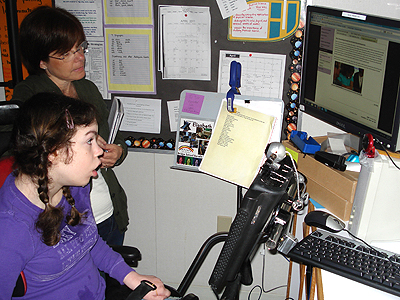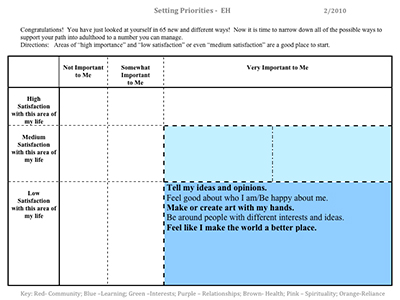Learning to prioritize, setting and sharing goals: Students review their completed Framing A Future (FAF) summary page to select a goal that they want to work towards.
Purpose
Students read and review their completed FAF planning tools. Students work with their mentor or a teacher to complete the “Setting Priorities” worksheet. Students select 2-3 items from the worksheet that are very important to them. Students use language to describe, explain and elaborate on reasons why these items are of high importance. Students share their responses with their mentors, other students and/or family members.

Activity
To participate in this activity, students need to have already completed the FAF planning tool. Please follow this link to The Bridge School’s FAF section of the site for a complete explanation of the tool and links to download the tool in its original or computer-adapted version. This activity can be completed in one long session or broken down into several smaller activities completed over several days.
- Students are given their completed FAF planning tool. Students and mentors read and review the student’s completed survey.
- Students work with their mentor or a teacher to complete the written “Setting Priorities” worksheet.
- When the worksheet is completed, students are asked to re-read the items listed in the blue box “Very Important to Me.”
- Students and their mentors select 2 or 3 of the listed items to work on.
- Students and their mentors work in pairs or small groups to discuss why those items are important to the student. Mentors and teachers activate student background knowledge and draw connections between items identified by the student and student interests, family activities, class subjects, etc.
- Students write down at least 1 reason why each item in the blue box has been identified as a priority.

Once the student and mentor have completed the worksheet and discussed 1 or 2 reasons why these items are of high importance, students come together in small groups to share their priorities. Students use their AAC systems, partner support and/or pre-recorded messages to share their responses. Mentors or teachers can lead discussions that give students opportunities to share information, know they’ve been heard and gain insight from the perspective of their mentor.
Adaptations
- Use computer-adapted “Setting Priorities” worksheet for alternate access.
- Read the worksheet and responses aloud to the student.
- Use text-to-speech word processing program, word prediction/completion software for writing support.
- Provide student-appropriate AAC systems to type responses directly into the answer fields on the form.
- Provide partner-assisted strategies with communication boards for students to dictate their responses.
- During the discussion portion of the activity, students can generate their responses using their speech-generating devices, or they can use partner-assisted strategies with communication boards.
- Provide the student linguistic support while brainstorming.
- Offer students plausible options based upon known student information. For example, if a student’s FAF survey listed “making art or being creative” as a “Very Important” item but the student has a hard time coming up with a reason why, point out to the student 3 potential reasons, such as:
- Because you love going to art museums
- Because your aunt works at an art supply store
- Because you feel like an artist or creative person

